
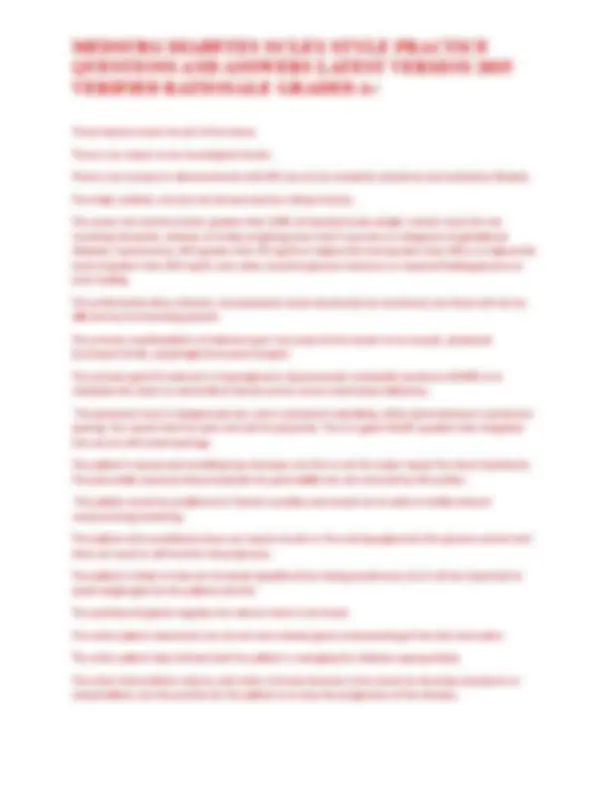
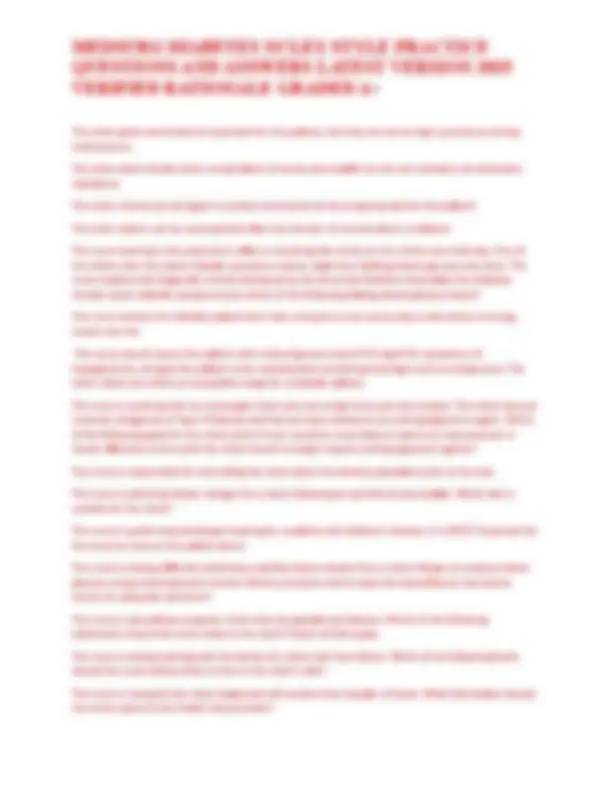

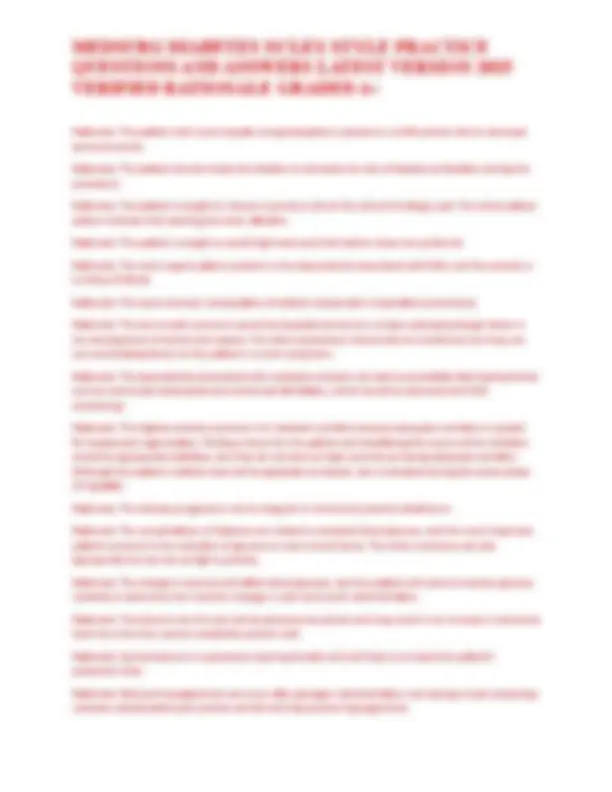
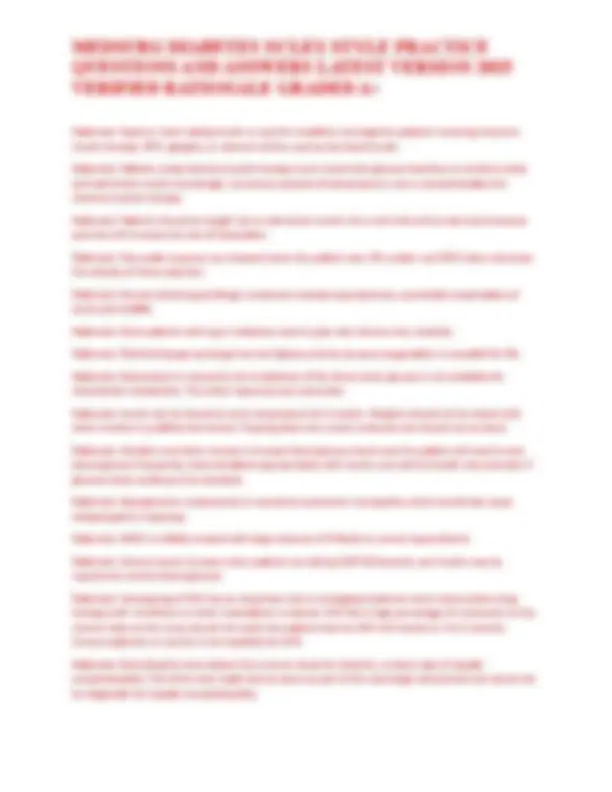
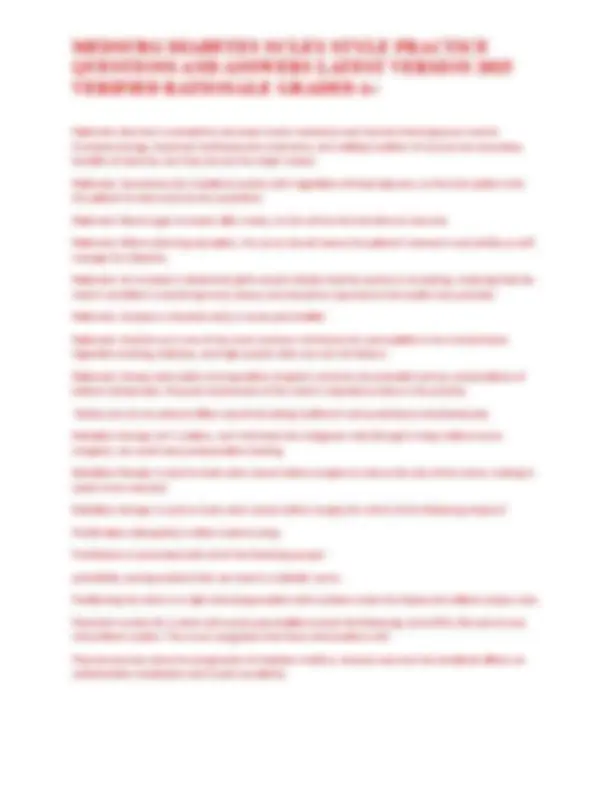
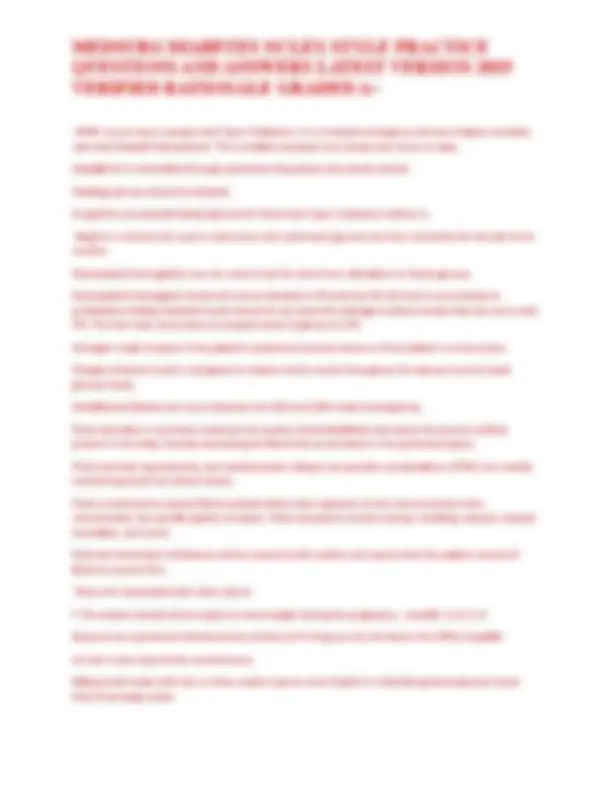
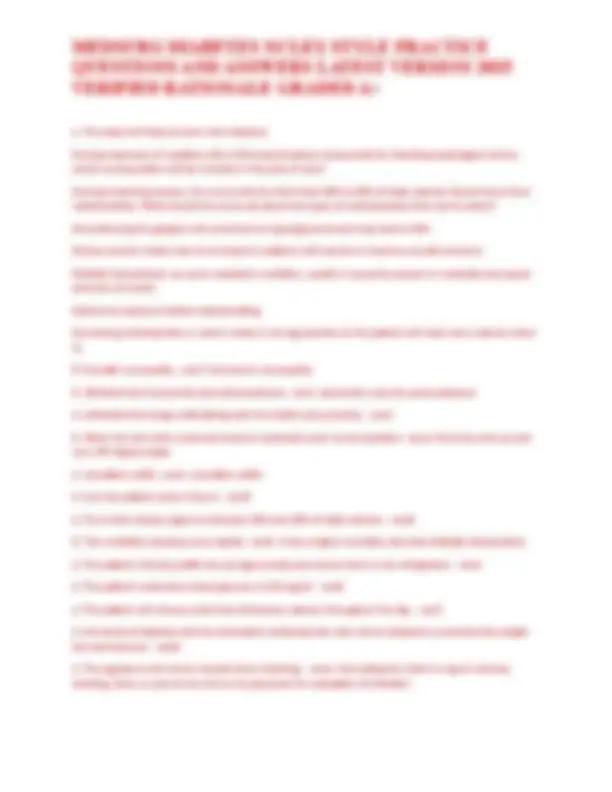
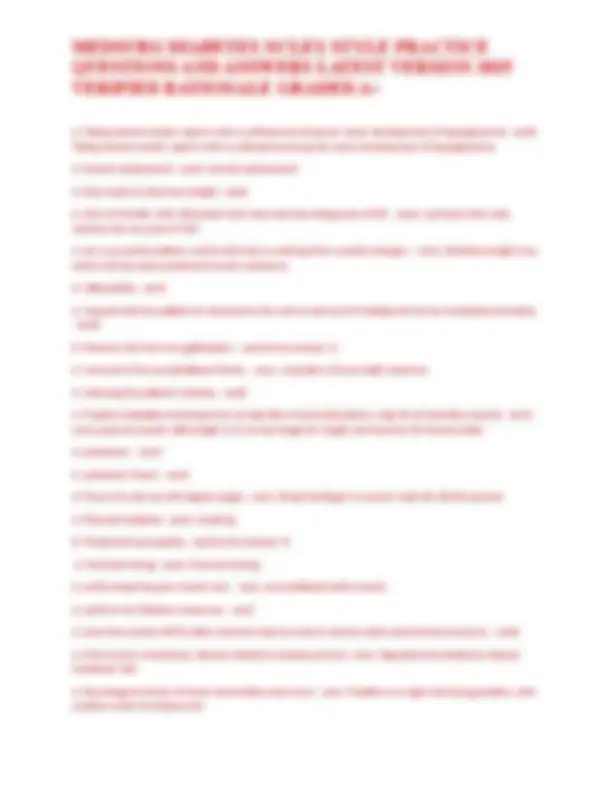
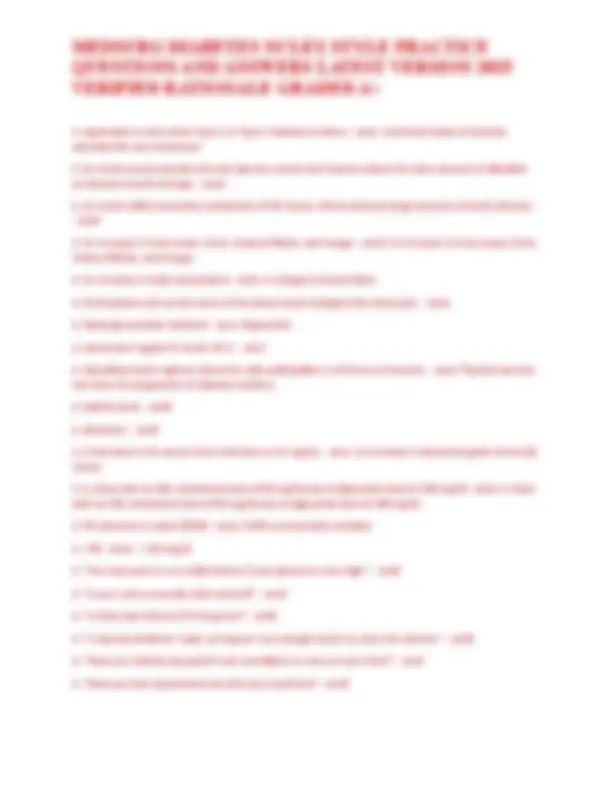
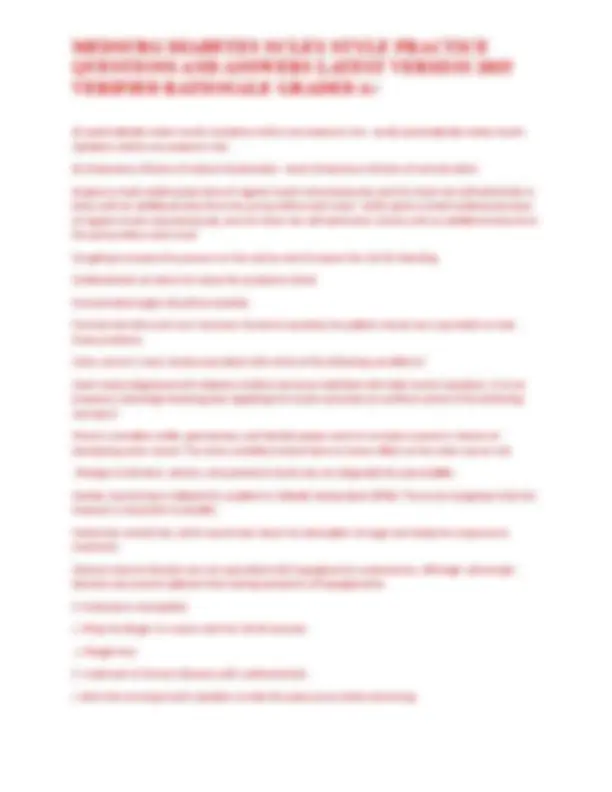
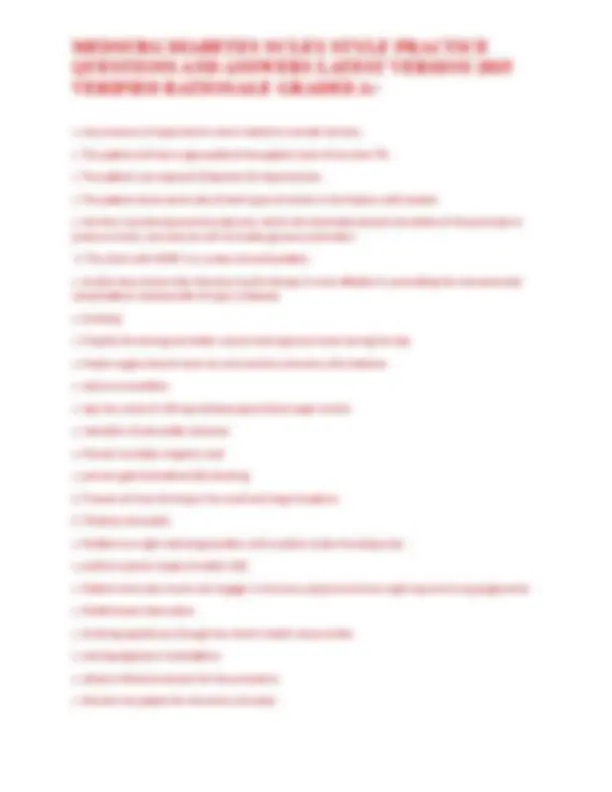
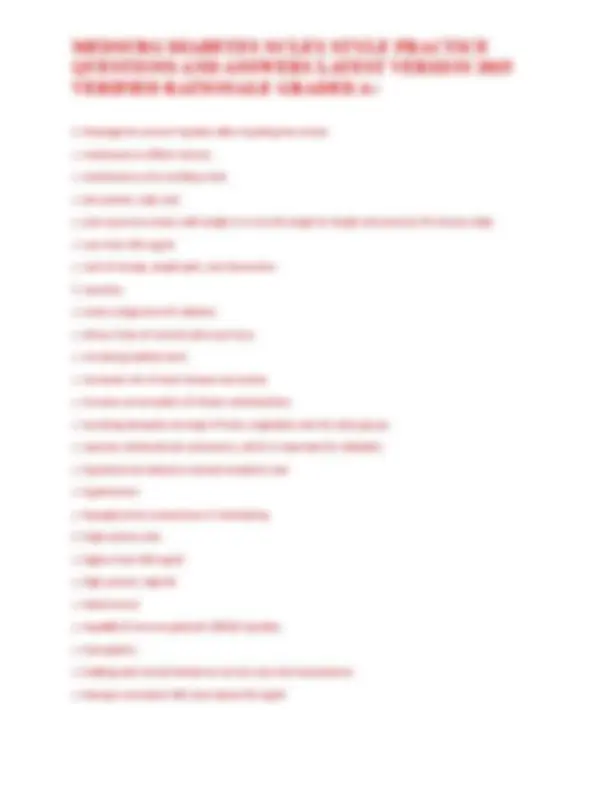
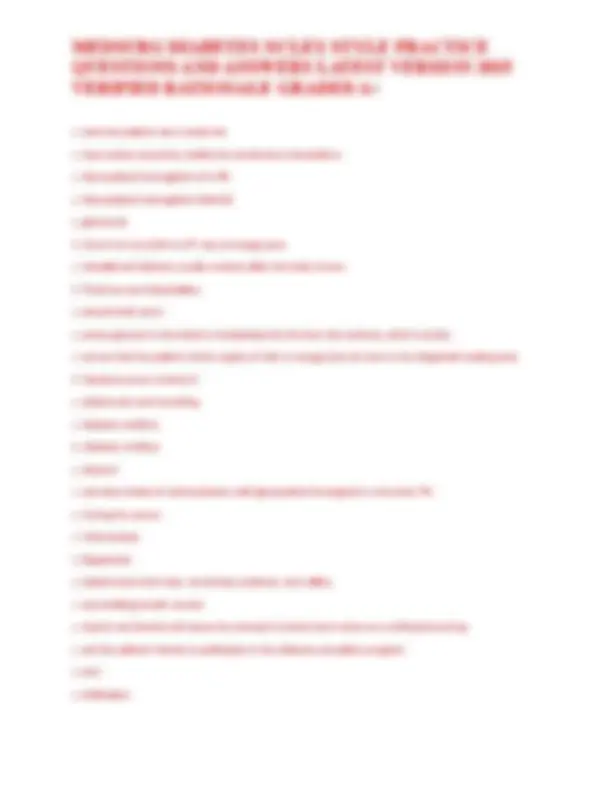
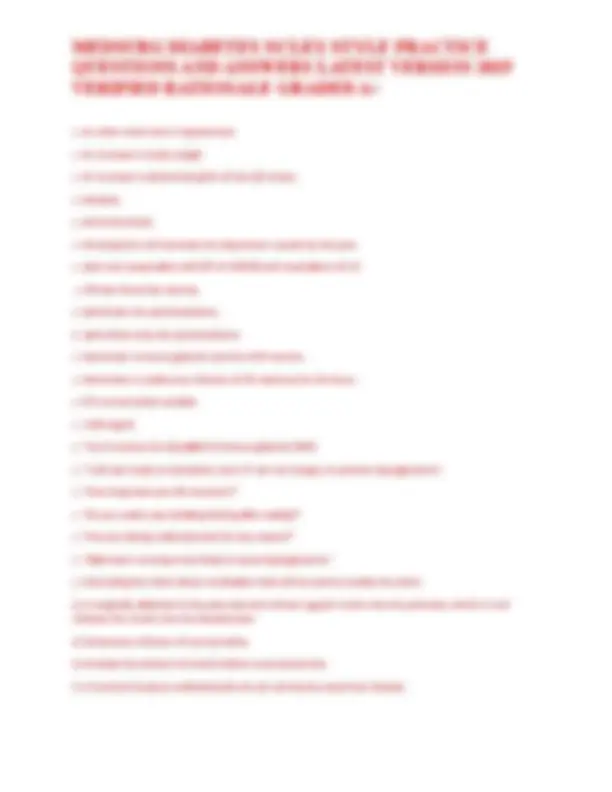
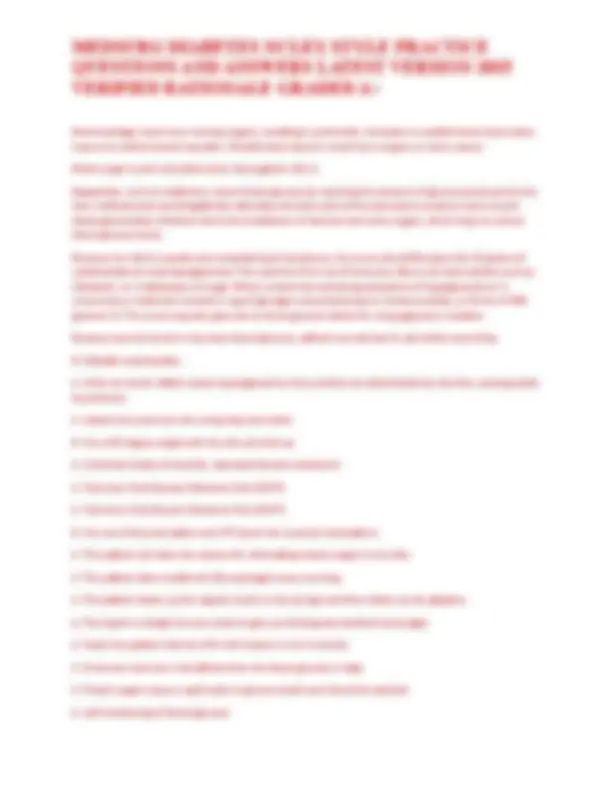
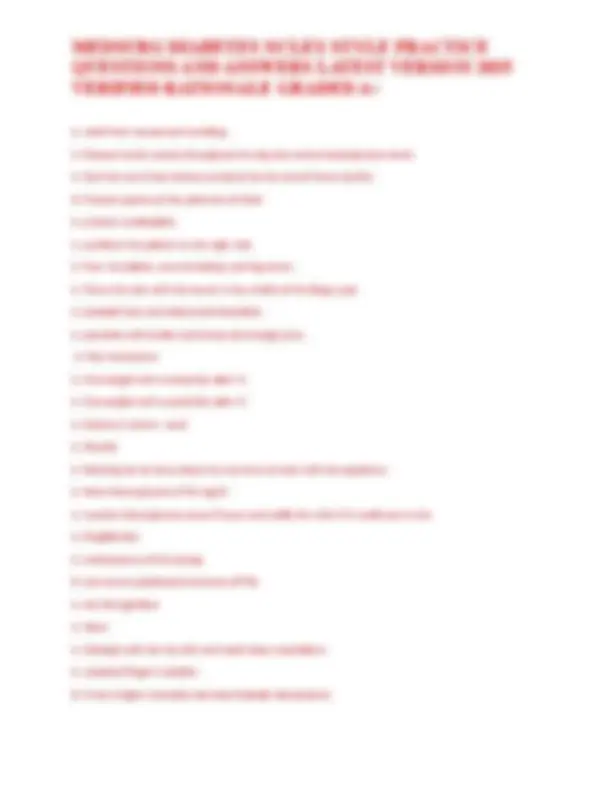
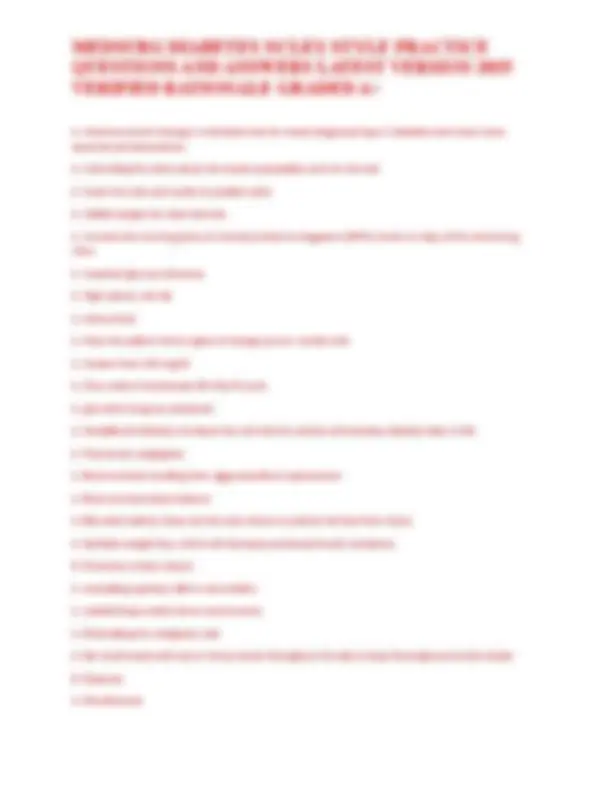
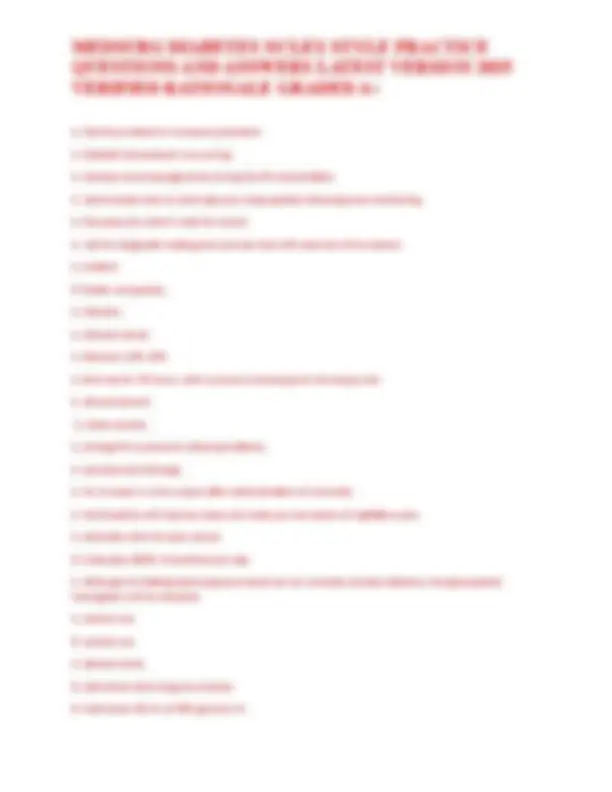
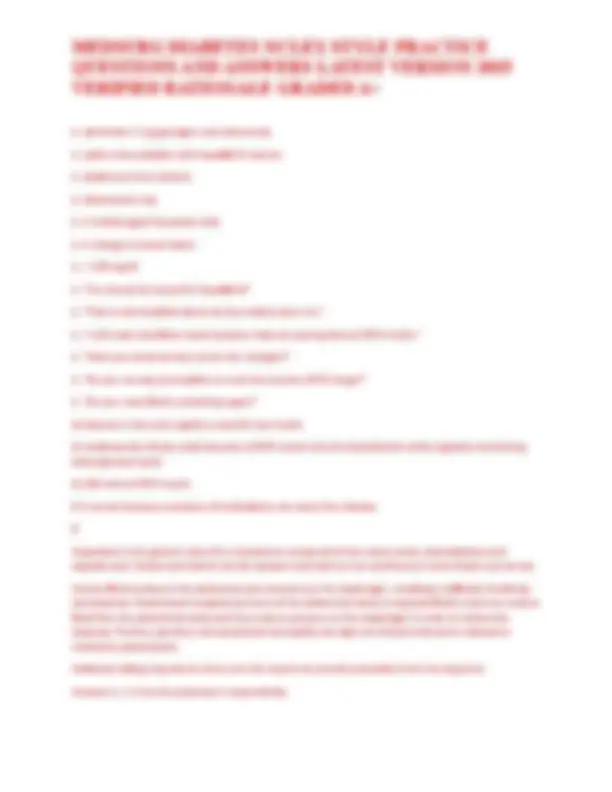
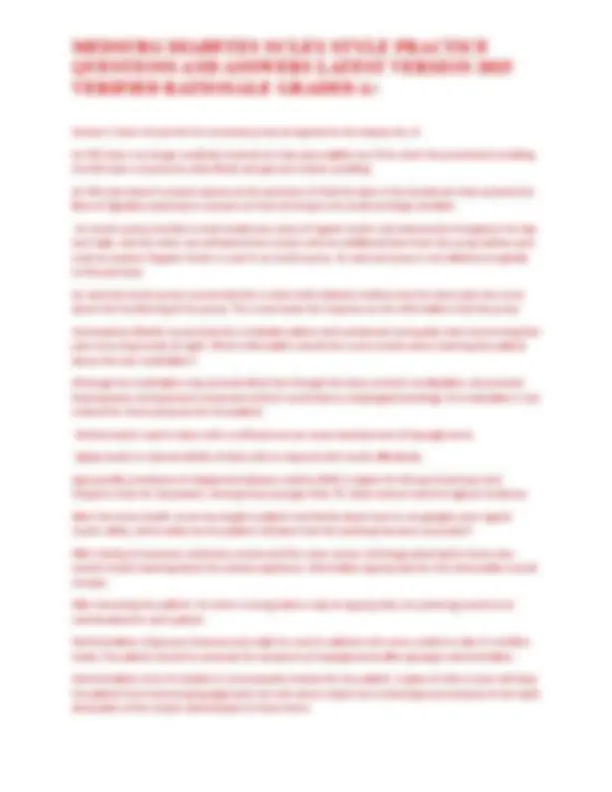
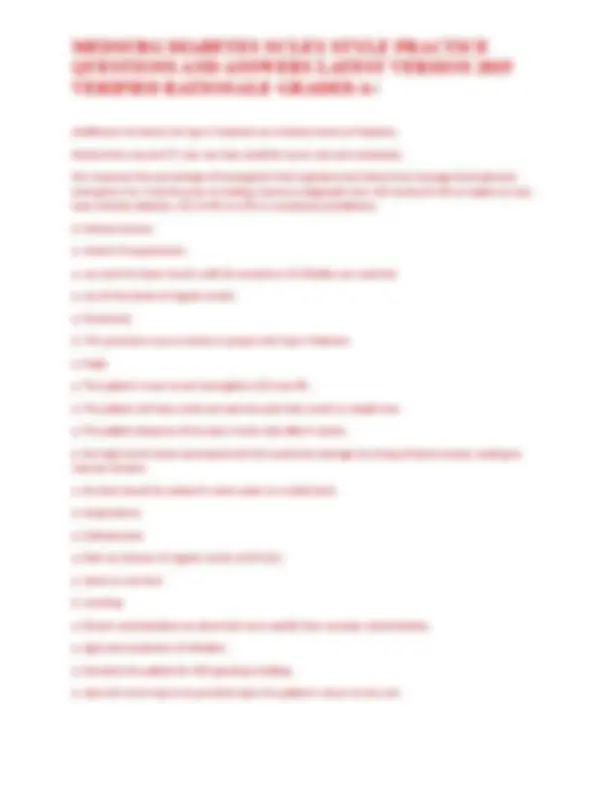
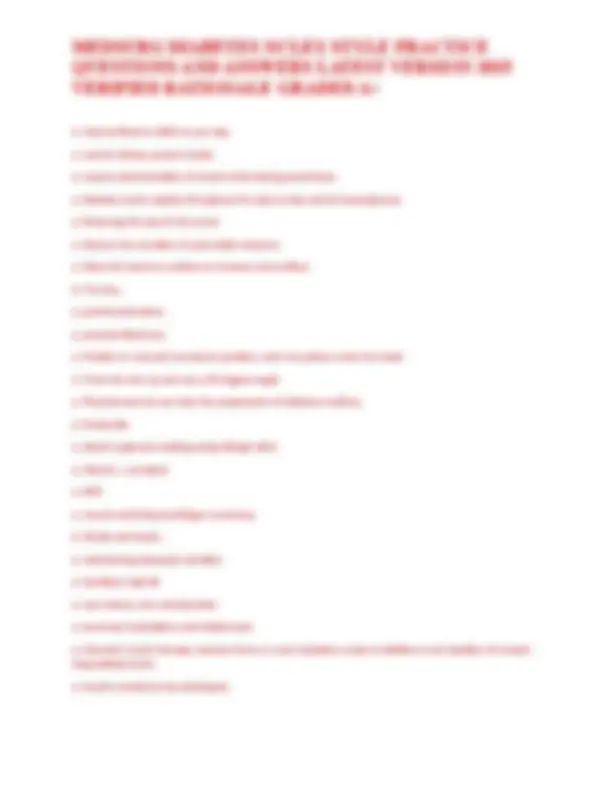
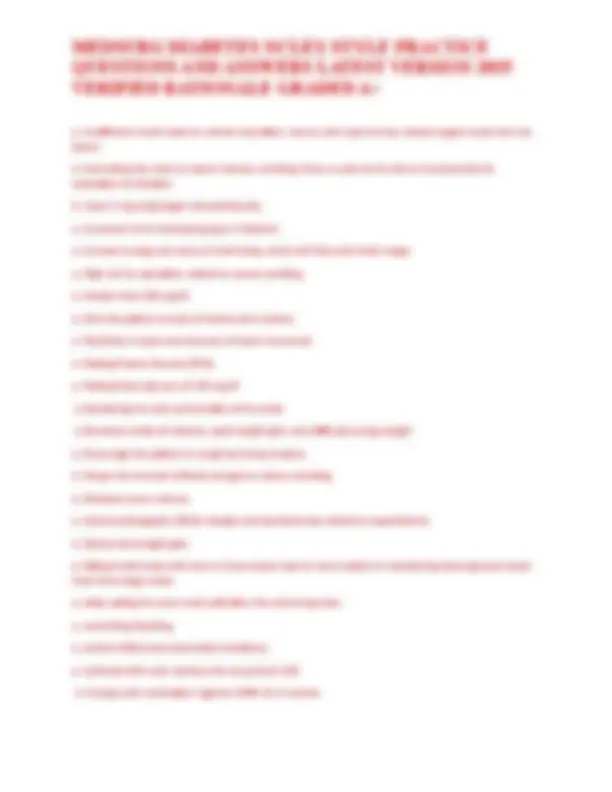
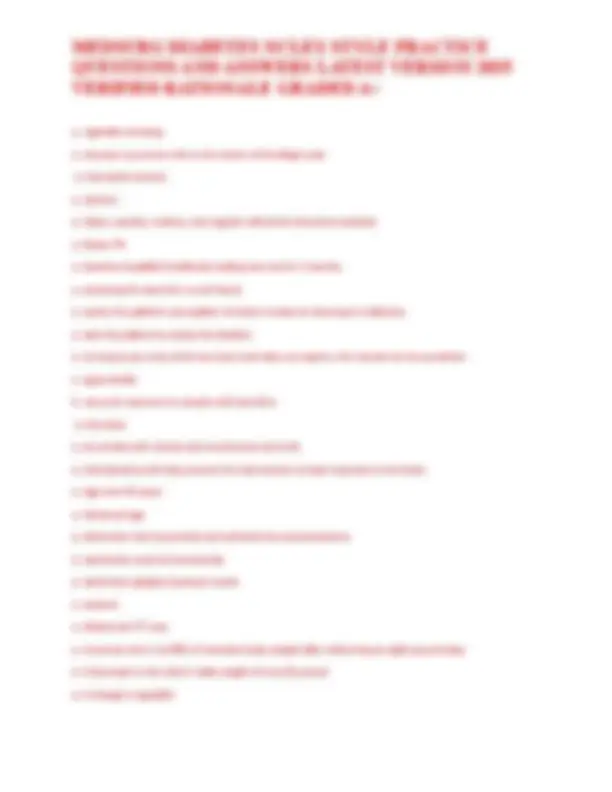
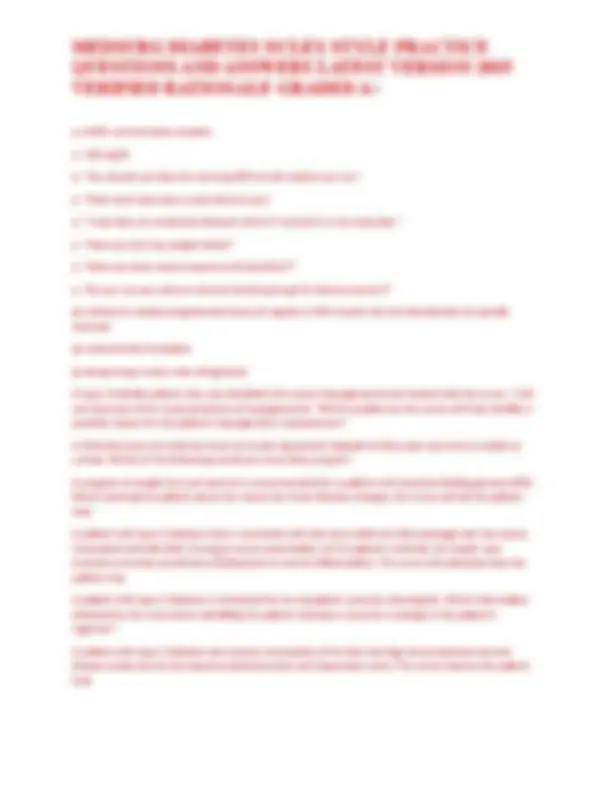
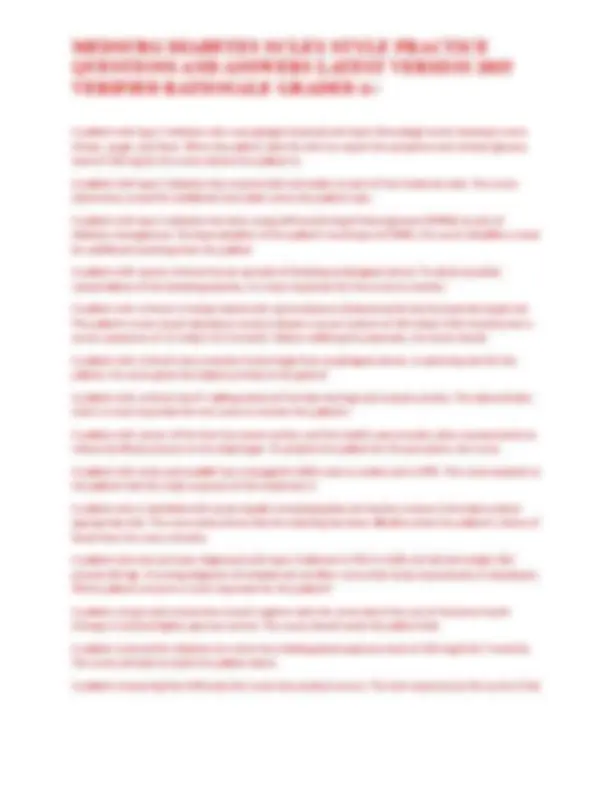
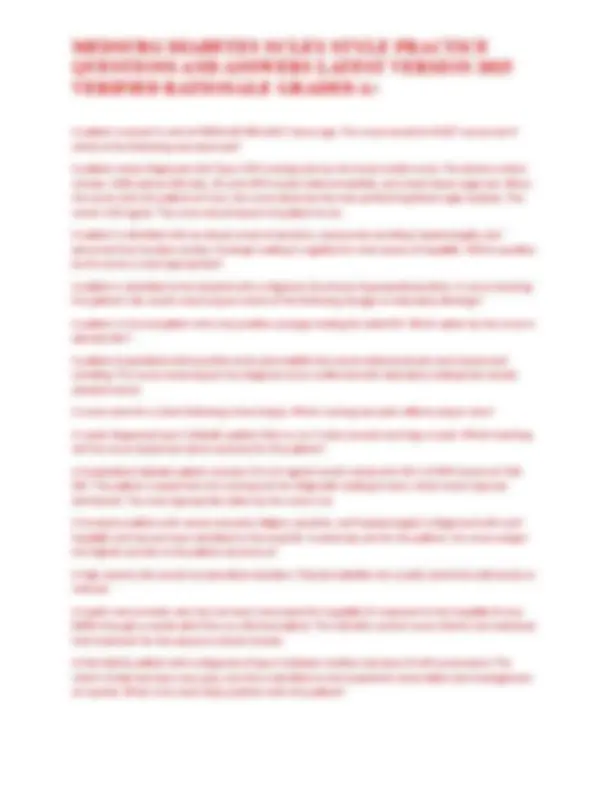
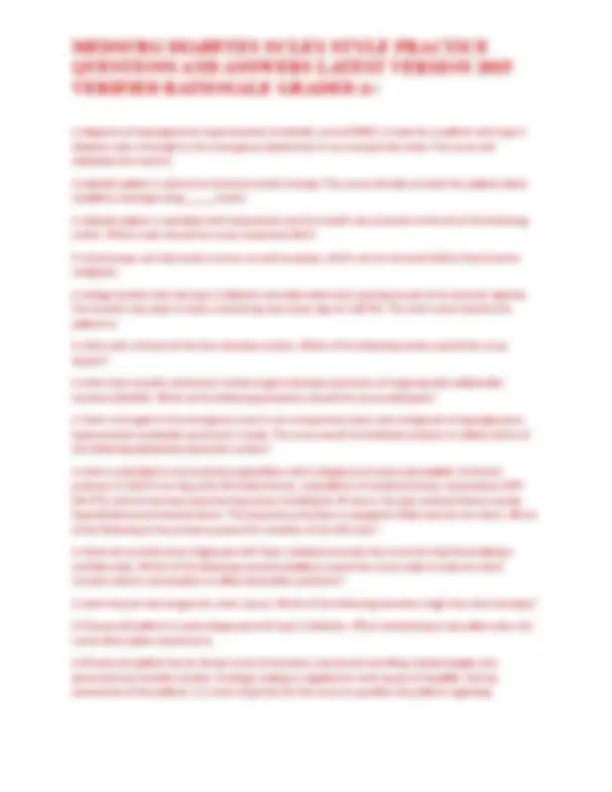
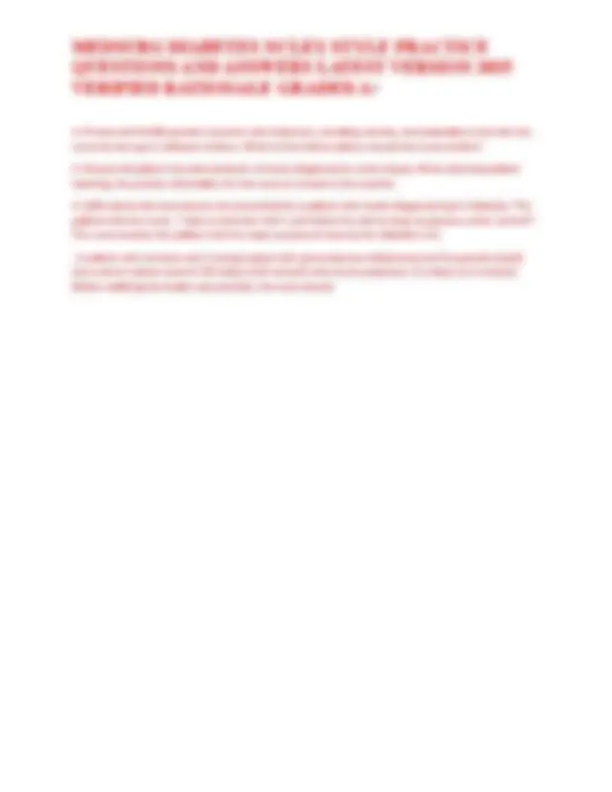



















Study with the several resources on Docsity

Earn points by helping other students or get them with a premium plan


Prepare for your exams
Study with the several resources on Docsity

Earn points to download
Earn points by helping other students or get them with a premium plan
Community
Ask the community for help and clear up your study doubts
Discover the best universities in your country according to Docsity users
Free resources
Download our free guides on studying techniques, anxiety management strategies, and thesis advice from Docsity tutors
MEDSURG DIABETES NCLEX STYLE PRACTICE QUESTIONS AND ANSWERS LATEST VERSION 2025 VERIFIED RATIONALE GRADED A+.pdf
Typology: Exams
1 / 55

This page cannot be seen from the preview
Don't miss anything!
















































You are doing some teaching with a client who is starting on a sulfonylurea antidiabetic agent. The client mentions that he usually has a couple of beers each night and takes an aspirin each day to prevent heart attack and/or strokes. Which of the following responses would be best on the part of the nurse? While preparing the client for a colonoscopy, the nurse's responsibilities include: While hospitalized and recovering from an episode of diabetic ketoacidosis, the patient calls the nurse and reports feeling anxious, nervous, and sweaty. Based on the patient's report, the nurse should Which one of the following methods/techniques will the nurse use when giving insulin to a thin person? [Hint] Which of these laboratory values noted by the nurse when reviewing the chart of a diabetic patient indicates the need for further assessment of the patient? Which of the following things must the nurse working with diabetic clients keep in mind about Hyperglycemic Hyperosmolar Nonketotic Syndrome (HHNS)? Which of the following symptoms is a client with colon cancer most likely to exhibit? Which of the following persons would most likely be diagnosed with diabetes mellitus? A 44-year-old: Which of the following is accurate pertaining to physical exercise and type 1 diabetes mellitus? Which of the following factors are risks for the development of diabetes mellitus? (Select all that apply.) Which of the following diets is most commonly associated with colon cancer? Which of the following diagnostic tests should be performed annually over age 50 to screen for colon cancer? Which of the following diabetes drugs acts by decreasing the amount of glucose produced by the liver? Which laboratory test should a nurse anticipate a physician would order when an older person is identified as high-risk for diabetes mellitus? (Select all that apply.) When working in the community, the nurse will recommend routine screening for diabetes when the person has one or more of seven risk criteria. Which of the following persons that the nurse comes in contact with most needs to be screened for diabetes based on the seven risk criteria? When type II diabetics lose weight through diet and exercise they sometimes have an improvement in insulin efficiency sufficient to the degree they no longer require oral hypoglycemic agents. When taking a health history, the nurse screens for manifestations suggestive of diabetes type I. Which of the following manifestations are considered the primary manifestations of diabetes type I and would be most suggestive of diabetes type I and require follow-up investigation?
When obtaining a health history from a patient with acute pancreatitis, the nurse asks the patient specifically about a history of When obtaining a health history from a patient with acute pancreatitis, the nurse asks the patient specifically about a history of When lactulose (Cephulac) 30 ml QID is ordered for a patient with advanced cirrhosis, the patient complains that it causes diarrhea. The nurse explains to the patient that it is still important to take the drug because the lactulose will When assessing the patient experiencing the onset of symptoms of type 1 diabetes, which question should the nurse ask? When assessing the neurologic status of a patient with a diagnosis of hepatic encephalopathy, the nurse asks the patient to When an older person is identified as high-risk for diabetes, appropriate testing would include FPG and OGTT. A FPG greater than 140 mg/dL usually indicates diabetes. The OGTT is to determine how the body responds to the ingestion of carbohydrates in a meal. HbA1C evaluates long-term glucose control. A finger stick glucose three times daily spot-checks blood glucose levels. When a client's carbohydrate consumption is inadequate ketones are produced from the breakdown of fat. When a client learned that the symptoms of diabetes were caused by high levels of blood glucose the client decided to stop eating carbohydrates. In this instance, the nurse would be concerned that the client would develop what complication? Weight gain should continue, but not in excessive amounts. Waiting to eat until after the procedure is likely to cause hypoglycemia. Usually, gestational diabetes disappears after the infant is born. However, diabetes can develop 5 to 10 years after the pregnancy. Turning the patient every 4 hours will not be adequate to maintain skin integrity. Thyroidectomy: - ansSemi Fowler and avoid hyperflexion and hyperextension of the neck Thyroid hormone deficiency results in reduction in the metabolic rate, resulting in hypothermia, and does predispose the older adult to a host of other health-related issues. One quarter of affected elderly experience constipation. This causes problems such as hepatic encephalopathy (neurologic syndrome that develops as a result of rising blood ammonia levels). Although other nutrients, such as fat and carbohydrates, may be regulated, it's most important to limit protein in the diet of the client with liver failure.
The other goals would also be important for this patient, but they are not as high a priority as airway maintenance. The other data indicate other complications of acute pancreatitis but are not indicators of electrolyte imbalance. The other choices are all higher in protein and would not be as appropriate for this patient. The other actions can be accomplished after the infusion of normal saline is initiated. The nurse working in the physician's office is reviewing lab results on the clients seen that day. One of the clients who has classic diabetic symptoms had an eight-hour fasting plasma glucose test done. The nurse realizes that diagnostic criteria developed by the American Diabetes Association for diabetes include classic diabetic symptoms plus which of the following fasting plasma glucose levels? The nurse teaches the diabetic patient who rides a bicycle to work every day to administer morning insulin into the The nurse should assess the patient with a blood glucose level of 52 mg/dl for symptoms of hypoglycemia, and give the patient some carbohydrate-containing beverage such as orange juice. The other values are within an acceptable range for a diabetic patient. The nurse is working with an overweight client who has a high-stress job and smokes. This client has just received a diagnosis of Type II Diabetes and has just been started on an oral hypoglycemic agent. Which of the following goals for the client which if met, would be most likely to lead to an improvement in insulin efficiency to the point the client would no longer require oral hypoglycemic agents? The nurse is responsible for instructing the client about the bowel preparation prior to the test. The nurse is planning dietary changes for a client following an episode of pancreatitis. Which diet is suitable for the client? The nurse is performing discharge teaching for a patient with Addison's disease. It is MOST important for the nurse to instruct the patient about: The nurse is having difficulty obtaining a capillary blood sample from a client's finger to measure blood glucose using a blood glucose monitor. Which procedure will increase the blood flow to the area to ensure an adequate specimen? The nurse is educating a pregnant client who has gestational diabetes. Which of the following statements should the nurse make to the client? Select all that apply. The nurse is doing teaching with the family of a client with liver failure. Which of the following foods should the nurse advise them to limit in the client's diet? The nurse is caring for the client diagnosed with ascites from hepatic cirrhosis. What information should the nurse report to the health-care provider?
The nurse is caring for patients in the student health center. A patient confides to the nurse that the patient's boyfriend informed her that he tested positive for Hepatitis B. Which of the following responses by the nurse is BEST? The nurse is caring for a patient with a diagnosis of hypothyroidism. Which nursing diagnosis should the nurse most seriously consider when analyzing the needs of the patient? The nurse is caring for a client with cirrhosis of the liver. The client has developed ascites and requires a paracentesis. Which of the following symptoms is associated with ascites and should be relieved by the paracentesis? The nurse identifies the collaborative problem of potential complication: electrolyte imbalance for a patient with severe acute pancreatitis. Assessment findings that alert the nurse to electrolyte imbalances associated with acute pancreatitis include The nurse identifies a nursing diagnosis of risk for impaired skin integrity for a patient with cirrhosis who has ascites and 4+ pitting edema of the feet and legs. An appropriate nursing intervention for this problem is to The nurse does not need to talk with the doctor before giving the spironolactone, although the health care provider should be notified about the low potassium value. The nurse assisting in the admission of a client with diabetic ketoacidosis will anticipate the physician ordering which of the following types of intravenous solution if the client cannot take fluids orally? The most common complaint of the client with colon cancer is a change in bowel habits. The health care provider is responsible for obtaining informed consent. The health care provider inserts the tube and verifies the position. The esophageal balloon is deflated every 8 to 12 hours to avoid necrosis, but if the gastric balloon is deflated, the esophageal balloon may occlude the airway. The hand is lowered to increase venous flow. The guidelines for Carbohydrate Counting as medical nutrition therapy for diabetes mellitus includes all of the following EXCEPT: The furosemide will further decrease the patient's potassium level and should be held until the nurse talks with the health care provider. The finger is pierced lateral to the middle of the pad perpendicular to the skin surface. The feet should be washed, but not soaked, in warm water daily.
Running can be done in either the morning or afternoon. If the glucose is very elevated, the patient should postpone the run. Risk factors for type 2 diabetes include all of the following except: Regular insulin, not NPH insulin, would be administered. The use of sodium bicarbonate to correct acidosis is avoided because it can precipitate a further drop in serum potassium levels. Intubation and mechanical ventilation are not required to treat HHNS. Regular insulin is administered, not a long-acting insulin. There is no indication that the patient requires oxygen. Dextrose solutions will increase the patient's blood glucose and would be contraindicated. Rationale: Weight loss occurs because the body is no longer able to absorb glucose and starts to break down protein and fat for energy. The patient is thirsty but does not necessarily crave sugar- containing fluids. Increased appetite is a classic symptom of type 1 diabetes. With the classic symptom of polyuria, urine will be very dilute. Rationale: Tricyclic antidepressants decrease the transmission of pain impulses to the spinal cord and brain. Tricyclics also improve sleep quality and are used for depression, but that is not the major purpose for their use in diabetic neuropathy. The blood vessel changes that contribute to neuropathy are not affected by tricyclics. Rationale: To avoid lactic acidosis, metformin should not be used for 48 hours after IV contrast media are administered. Rationale: The recommended treatment for exposure to hepatitis B in unvaccinated individuals is to receive both HBIG and the hepatitis B vaccine, which would provide temporary passive immunity and promote active immunity. Rationale: The purpose for lactulose in the patient with cirrhosis is to lower ammonia levels and prevent encephalopathy. Rationale: The pressure-relieving mattress will decrease the risk for skin breakdown for this patient. Rationale: The patient's symptoms, lack of antibodies for hepatitis, and the ABRUPT onset of symptoms suggest toxic hepatitis, which can be caused by commonly used OTC drugs such as acetaminophen (Tylenol). Rationale: The patient's impaired fasting glucose indicates pre-diabetes and the patient should be counseled about LIFESTYLE CHANGES to prevent the development of type 2 diabetes. Rationale: The patient's clinical manifestations are consistent with hypoglycemia and the initial action should be to check the patient's glucose with a finger stick or order a stat blood glucose. Rationale: The patient with IFG is at risk for developing type 2 diabetes, but this risk can be decreased with lifestyle changes.
Rationale: The patient with acute hepatic encephalopathy is placed on a LOW-protein diet to decrease ammonia levels. Rationale: The patient should empty the bladder to decrease the risk of bladder perforation during the procedure. Rationale: The patient is taught to choose a puncture site at the side of the finger pad. The other patient actions indicate that teaching has been effective. Rationale: The patient is taught to avoid high heels and that leather shoes are preferred. Rationale: The most urgent patient problem is the hypovolemia associated with DKA, and the priority is to infuse IV fluids. Rationale: The most common complication of balloon tamponade is aspiration pneumonia. Rationale: The low oncotic pressure caused by hypoalbuminemia is a major pathophysiologic factor in the development of ascites and edema. The other parameters should also be monitored, but they are not contributing factors to the patient's current symptoms. Rationale: The hypokalemia associated with metabolic acidosis can lead to potentially fatal dysrhythmias such as ventricular tachycardia and ventricular fibrillation, which would be detected with ECG monitoring. Rationale: The highest priority outcome is to maintain nutrition because adequate nutrition is needed for hepatocyte regeneration. Finding a home for the patient and identifying the source of the infection would be appropriate activities, but they do not have as high a priority as having adequate nutrition. Although the patient's activity level will be gradually increased, rest is indicated during the acute phase of hepatitis. Rationale: The disease progression can be stopped or reversed by alcohol abstinence. Rationale: The complications of diabetes are related to elevated blood glucose, and the most important patient outcome is the reduction of glucose to near-normal levels. The other outcomes are also appropriate but are not as high in priority. Rationale: The change in exercise will affect blood glucose, and the patient will need to monitor glucose carefully to determine the need for changes in diet and insulin administration. Rationale: The blood in the GI tract will be absorbed as protein and may result in an increase in ammonia level since the liver cannot metabolize protein well. Rationale: Spironolactone is a potassium-sparing diuretic and will help to increase the patient's potassium level. Rationale: Rebound hypoglycemia can occur after glucagon administration, but having a meal containing complex carbohydrates plus protein and fat will help prevent hypoglycemia.
Rationale: Exercise is essential to decrease insulin resistance and improve blood glucose control. Increased energy, improved cardiovascular endurance, and setting a pattern of success are secondary benefits of exercise, but they are not the major reason. Rationale: Consistency for mealtimes assists with regulation of blood glucose, so the best option is for the patient to have lunch at the usual time. Rationale: Blood sugar increases after meals, so this will be the best time to exercise. Rationale: Before planning education, the nurse should assess the patient's interest in and ability to self- manage the diabetes. Rationale: An increase in abdominal girth would indicate that the ascites is increasing, meaning that the client's condition is becoming more serious and should be reported to the health-care provider. Rationale: Amylase is elevated early in acute pancreatitis. Rationale: Alcohol use is one of the most common risk factors for pancreatitis in the United States. Cigarette smoking, diabetes, and high-protein diets are not risk factors. Rationale: Airway obstruction and aspiration of gastric contents are potential serious complications of balloon tamponade. Frequent assessment of the client's respiratory status is the priority. Rashes are not an adverse effect caused by taking metformin and prednisone simultaneously. Radiation therapy isn't curative, can't eliminate the malignant cells (though it helps define tumor margins), can could slow postoperative healing. Radiation therapy is used to treat colon cancer before surgery to reduce the size of the tumor, making it easier to be resected. Radiation therapy is used to treat colon cancer before surgery for which of the following reasons? Proliferative retinopathy is often treated using: Prediabetes is associated with all of the following except: potentially causing acidosis that can lead to a diabetic coma. Positioning the client in a right side-lying position with a pillow under the biopsy site reflects proper care. Physician's orders for a client with acute pancreatitis include the following: strict NPO, NG tube to low intermittent suction. The nurse recognizes that these interventions will: Physical exercise slows the progression of diabetes mellitus, because exercise has beneficial effects on carbohydrate metabolism and insulin sensitivity.
Persons with elevated glucose levels that do not yet meet the criteria for diabetes are considered to have prediabetes and are at increased risk of developing type 2 diabetes. Weight loss and increasing physical activity can help people with prediabetes prevent or postpone the onset of type 2 diabetes. Patients who are using intensified insulin therapy have considerable flexibility in diet choices but still should restrict dietary intake of items such as fat, protein, and alcohol. Passive range of motion will not take pressure off areas like the sacrum that are vulnerable to breakdown. Parathyroid hormone levels may be high or normal but not low. Overweight with waist/hip ratio increase is part of the metabolic syndrome of DM II. Orange juice and nonfat milk will elevate blood sugar rapidly, but the cheese and crackers will stabilize blood sugar. One of the benefits of Glargine (Lantus) insulin is its ability to: Of which of the following symptoms might an older woman with diabetes mellitus complain? NPH insulin will not peak until mid-afternoon and is safe to take before a morning run. Mr. L. has a seven-year history of hepatic cirrhosis. He was brought to the emergency room because he began vomiting large amounts of dark-red blood. An Esophageal Balloon Tamponade tube was inserted to tamponade the bleeding esophageal varices. While the balloon tamponade is in place, the nurse caring for Mr. L. gives the highest priority to Meats and beans are high-protein foods and are restricted with liver failure. low fiber, high fat diet reduced motility and increases the chance of constipation. The metabolic end products of this type of diet are carcinogenic. A LOW FAT HIGH FIBER diet is recommended to help avoid colon cancer. Carbohydrates and protein aren't necessarily associated with colon cancer. Loop diuretics (such as furosemide) are usually ordered, and Maalox® (a bismuth subsalicylate) may interfere with the action of the diuretics. Liver biopsy: - ansRight side position post procedure to prevent patient from bleeding. It is recommended that carbohydrates provide 50% to 60% of the daily calories. Approximately 40% to 50% should be from complex carbohydrates. The remaining 10% to 20% of carbohydrates could be from simple sugars. Research provides no evidence that carbohydrates from simple sugars are digested and absorbed more rapidly than are complex carbohydrates, and they do not appear to affect blood sugar control. Intravenous fluid replacement is similar to that administered in diabetic ketoacidosis (DKA) and begins with IV infusion of normal saline.
HHNS occurs only in people with Type II Diabetes. It is a medical emergency and has a higher mortality rate than Diabetic Ketoacidosis. This condition develops very slowly over hours or days. Hepatitis B is transmitted through parenteral drug abuse and sexual contact. Heating pad use should be avoided. he goal for pre-prandial blood glucose for those with Type 1 diabetes mellitus is: HbgA1c is a blood test used to determine how well blood glucose has been controlled for the last three months. Glycosylated hemoglobins are not used to test for short-term alterations in blood glucose. Glycosylated hemoglobin levels will not be elevated in IFG and the Hb A1C test is not included in prediabetes testing. Elevated insulin levels do not cause the damage to blood vessels that can occur with IFG. The liver does not produce increased levels of glucose in IFG Glucagon might be given if the patient's symptoms become worse or if the patient is unconscious. Glargine (Lantus) insulin is designed to release insulin evenly throughout the day and control basal glucose levels. Gestational diabetes can occur between the 16th and 28th week of pregnancy. Fluid restriction is a primary treatment for ascites. Restricting fluids decreases the amount of fluid present in the body, thereby decreasing the fluid that accumulates in the peritoneal space. Fluid overload, hypovolemia, and cardiovascular collapse are possible complications of DKA, but cardiac monitoring would not detect theses. Fluid is restricted to prevent fluid overload rather than replaced. As the urine becomes more concentrated, the specific gravity increases. Other symptoms include nausea, vomiting, seizures, altered mentation, and coma. Fluid and electrolyte imbalances will be caused by NG suction and require that the patient receive IV fluids to prevent this. Fever isn't associated with colon cancer. f. The mother should strive to gain no more weight during the pregnancy. - ansANS: A, B, C, D Exposure to a jaundiced individual and a history of IV drug use are risk factors for VIRAL hepatitis. ed rest is only required for several hours. Eating small meals with two or three snacks may be more helpful in maintaining blood glucose levels than three large meals.
e. The baby will likely be born with diabetes During treatment of a patient with a Minnesota balloon tamponade for bleeding esophageal varices, which nursing action will be included in the plan of care? During a teaching session, the nurse tells the client that 50% to 60% of daily calories should come from carbohydrates. What should the nurse say about the types of carbohydrates that can be eaten? Discontinuing the glargine will contribute to hyperglycemia and may lead to DKA. Dietary protein intake may be increased in patients with ascites to improve oncotic pressure. Diabetic ketoacidosis, an acute metabolic condition, usually is caused by absent or markedly decreased amounts of insulin. Determine exposure before implementing. Decreasing carbohydrate or caloric intake is not appropriate as the patient will need more calories when ill. D: Somatic neuropathy - ansC: Autonomic neuropathy D. Withhold the furosemide and spironolactone - ansC. administer only the spironolactone d. withhold both drugs until talking with the health care provider. - ansC D. Warm the skin with a warmed towel or washcloth prior to the injection - ansa. Pinch the skin up and use a 90 degree angle d. ulcerative colitis - ansd. ulcerative colitis d. turn the patient every 4 hours. - ansB d. Try to limit simple sugars to between 10% and 20% of daily calories. - ansD D. This condition develops very rapidly - ansB. It has a higher mortality rate than Diabetic Ketoacidosis d. The patient's family prefills the syringes weekly and stores them in the refrigerator. - ansA d. The patient's admission blood glucose is 128 mg/dl. - ansB d. The patient will choose a diet that distributes calories throughout the day. - ansC d. the onset of diabetes and the associated cardiovascular risks can be delayed or prevented by weight loss and exercise. - ansD d. The appliance will not be needed when traveling. - ansa. Instructing the client to report redness, swelling, fever, or pain at the site to the physician for evaluation of infection
d. need a diet higher in calories while receiving prednisone. - ansA d. maintenance of a healthy weight. - ansD d. Maintaining a sedentary lifestyle - ansa. Age over 45 years d. Maintaining a sedentary lifestyle D. Maalox 30 ml P.O. BID. - ansCorrect answer: A D. Low urine specific gravity. - ansCorrect answer: A D. Low urine calcium. - ansAnswer: A d. Low protein, high carbohydrate - ansb. High calorie, low fat d. low carb, high protein - ansa. a. low fiber, high fat d. long-term, low-dose corticosteroids. - ansB d. limit intake to non-calorie-containing liquids until the glucose is within the usual range. - ansB d. Laser surgery - ansd. Laser surgery d. Insulin injections may be necessary. d. Instruct the patient on self-administration of - interferon. - ansA d. Increased risk of developing type 1 diabetes - ansD: Increased risk of developing type 1 diabetes d. improve nervous system function. - ansd. improve nervous system function. d. identifying the source of exposure to hepatitis. - ansA d. Hyperglycemic hyperosmolar non-ketotic coma - ansd. Hyperglycemic hyperosmolar non-ketotic coma d. hyperglycemia. - ansA d. Hispanic male. - ansc. African-American woman. d. high-protein diet. - ansB D. high-fat dietary intake - ansAnswer: B pancreatitis is associated with alcoholism d. Higher than 160 mg/dl - ansd. Higher than 160 mg/dl d. Hemoglobin A1C of 5.8% - ansb. Noon blood glucose of 52 mg/dl d. Helping the bowel heal after surgery - ansa. Reducing the size of the tumor d. headache and polyuria - ansc. diaphoresis and trembling
d. have the patient drink 4 ounces of orange juice. - ansA d. hangs the arm down for a minute before puncturing the site. - ansA d. glargine - ansB D. Give the client four to six glucose tablets. - ansCorrect answer: C d. give 50% dextrose as a bolus. - ansC d. Finger stick glucose three times daily - ansa. Fasting Plasma Glucose (FPG) d. Fecal occult blood test - ansd. Fecal occult blood test D. exposure to children recently immunized for hepatitis B - ansA and D assess for exposure to hepatitis. Hepatitis was ruled out this is inappropriate. d. Explaining the results of the exam - ansb. Instructing the client about the bowel preparation prior to the test d. Eliminate the need for analgesia - ansa. Reduce the secretion of pancreatic enzymes d. discuss the need for the patient to actively participate in diabetes management. - ansA d. Deflate the gastric balloon q8-12hr. - ansc. Monitor the patient for shortness of breath. d. Complete bowel obstruction - ansa. Peritonitis d. check glucose level before, during, and after swimming. - ansd. check glucose level before, during, and after swimming. d. Cause hypoglycemia with other manifestation of other adverse reactions. - ansb. Release insulin evenly throughout the day and control basal glucose levels. d. cardiovascular collapse resulting from the effects of hyperglycemia. - ansA D. Cakes and pastries. - ansCorrect answer: A d. both the hepatitis B vaccine and HBIG injection. - ansD d. Between 90 and 130 mg/dL - ansa. Below 7% d. baked chicken with french-fries, low-fiber bread, and tea. - ansb. pancakes with butter and honey and orange juice. d. assists the patient to lie flat in bed. - ansA d. Assess the patient for symptoms of hyperglycemia. - ansA
d) systematically rotate insulin injections within one anatomic site - ansd) systematically rotate insulin injections within one anatomic site d) intravenous infusion of sodium bicarbonate - ansc) intravenous infusion of normal saline d) gives a small continuously dose of regular insulin subcutaneously, and the client can self-administer a bolus with an additional dose form the pump before each meal - ansD.) gives a small continuously dose of regular insulin subcutaneously, and the client can self-administer a bolus with an additional dose form the pump before each meal Coughing increases the pressure on the varices and increases the risk for bleeding. Corticosteroid use does not cause the symptoms listed. Concentrated sugars should be avoided. Commercial callus and corn removers should be avoided; the patient should see a specialist to treat these problems. Colon cancer is most closely associated with which of the following conditions? client newly diagnosed with diabetes mellitus has been stabilized with daily insulin injections. A nurse prepares a discharge teaching plan regarding the insulin and plans to reinforce which of the following concepts? Chronic ulcerative colitis, granulomas, and familial polyps seem to increase a person's chance of developing colon cancer. The other conditions listed have no known effect on the colon cancer risk. Changes in bilirubin, calcium, and potassium levels are not diagnostic for pancreatitis. Cardiac monitoring is initiated for a patient in diabetic ketoacidosis (DKA). The nurse recognizes that this measure is important to identify Candy bars contain fat, which would slow down the absorption of sugar and delay the response to treatment. Calcium-channel blockers are not associated with hypoglycemic unawareness, although - adrenergic blockers can prevent patients from having symptoms of hypoglycemia. C: Autonomic neuropathy c. Wrap the finger in a warm cloth for 30-60 seconds. c. Weight loss C. treatment of chronic diseases with corticosteriods c. time the morning insulin injection so that the peak occurs while swimming.
c. the presence of hypovolemic shock related to osmotic diuresis. c. The patient will have a glycosylated hemoglobin level of less than 7%. c. The patient uses captopril (Capoten) for hypertension. c. The patient stores extra vials of both types of insulin in the freezer until needed. c. the liver is producing excessive glucose, which will eventually exhaust the ability of the pancreas to produce insulin, and exercise will normalize glucose production. C. The client with HHNS is in a state of overhydration c. studies have shown that intensive insulin therapy is most effective in preventing the macrovascular complications characteristic of type 2 diabetes. c. Smoking c. Simplify the dosing and better control blood glucose levels during the day. c. Simple sugars should never be consumed by someone with diabetes. c. seizure precautions c. says the result of 130 mg indicates good blood sugar control. c. reduction of pancreatic enzymes. c. Prevent secretion of gastric acid c. prevent gastrointestinal (GI) bleeding. C. Prevent air from forming in the small and large intestines. C. Potatoes and pasta. c. Position to a right side-lying position, with a pillow under the biopsy site c. perform passive range of motion QID. c. Patients who take insulin and engage in strenuous physical exercise might experience hyperglycemia. c. Partial bowel obstruction c. Ordering appliances through the client's health care provider c. oral hypoglycemic medications. c. obtains informed consent for the procedure. c. Monitor the patient for shortness of breath.